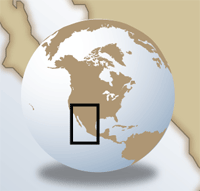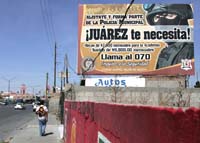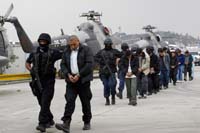 Getty Images
Getty Images
Article
Over 5,300 Mexicans died in drug-related killings in 2008—gunned down, tortured, beheaded—all to maintain the flow of illegal drugs into the United States. Where does the blame lie?
Learn the why behind the headlines.
Subscribe to the Real Truth for FREE news and analysis.
Subscribe NowIn El Paso, Texas, a mother finishes a bedtime story and tucks her daughter into bed, kissing her goodnight. After heading downstairs, she hears the distant pop of gunfire echoing through the crisp night air.
Must be Juarez, she thinks and enters the kitchen to finish the dishes. Why should she worry about the city across the border? After all, this is El Paso—the third-safest city in the United States.
Things have been changing though. There have been increased incidences of kidnapping. Refugees from war-torn Juarez have begun to cross the border, seeking shelter in the States. Hotel capacity is often near 100%, with Juarez citizens looking for one night of peace. El Paso’s city council unanimously signed a solidarity agreement to support Juarez. The trouble in Mexico is beginning to be noticed in America.
But for the mother doing dishes, it is hard to imagine the appalling conditions just across the border.
At daybreak in a once-frequented park in Juarez, the light illuminates a horrific scene: headless corpses dumped in plain sight.
Tourists used to stream across from its sister city, El Paso, eager to buy trinkets and souvenirs. The streets now are bare. So are schools, with parents keeping children home in fear for their safety.
Here drug gangs are the law—judge, jury and executioner—vehemently defending trade routes in what the U.S. Government Accountability Office estimates is a $23 billion a year industry.
Gangs extort store owners, but many cannot pay and are forced to close, fearing for their lives. Those who do not pay are likely to be kidnapped, tortured or killed. Heads of gang victims can be seen on fence posts, warning everyone to think twice before crossing a ruling cartel.
Welcome to Ciudad Juarez.
The Mexican “border town” of 1.7 million had an estimated 1,600 drug related-murders in 2008, the death toll rising faster than in Baghdad. In the first days of 2009, over 30 were killed in the city from drug violence.
“One speaks of failed states, Ciudad Juarez is a failed city,” George W. Grayson, an expert on Mexico-U.S. relations at the College of William and Mary in Virginia, said. “It’s a no man’s land. It’s totally out of control” (Associated Press).
The trouble is not limited to Juarez. The drug cartels have a steely grip on many of the Mexican towns bordering the United States. Throughout Mexico, the death toll was up 117% over the previous year—from 2,477 in 2007 to more than 5,300 in 2008.
The Mexican government has been fighting back, yet the body count continues to rise. The United States also fears its southern neighbor will crumple into a “narco-state” ruled by feuding drug lords—or worse, the violence will spill across the border.
Living in Fear
A wave of killings occurred in December 2008, including the gruesome discovery of eight tortured bodies in the state of Chiapas, in southeastern Mexico on Dec. 23. Three of the bodies were identified as local merchants.
The findings came just two days after Mexican authorities had uncovered nine decapitated bodies and their severed heads in the southeastern state of Guerrero. Eight were identified as soldiers, with the ninth body being that of a high-ranking police official.
These grim stories come across newswires with mind-numbing frequency. Some weeks the violence escalates. In one instance more than 100 lives were claimed in seven days. A week in December of 2008 included the deaths of 20 police officers. Also, Voice of America reported that cartel hit men assassinated nine federal agents.
For millions of Mexicans, these are not isolated events—they are a way of life.
 MCT
MCT
Drug gangs hold onto their territory with brute violence and intimidation. There is little doubt who rules the streets.
Kidnapping is another rampant terror. The Citizen’s Institute for Crime Studies estimates there are over 500 per month in Mexico. A December 2008 report by strategic consulting firm B.R. McCaffrey Associates stated that the majority of kidnappings are “not reported largely because of lack of trust in the police—or the reality of police involvement with the crime.”
And it is not just the rich who are targeted. “Now even poor Mexicans present a target for ATM [automated teller machine] extortion or even death because of non-payment of small ransoms,” the report said.
Death, destruction, carnage, extortion, fear—as the bodies pile up and the conflict threatens to spread into the Unites States, who or what is to blame for this drug war and its bloodied, lawless conditions?
Turf Wars
It seems obvious, one might logically reason. The members of the drug cartels are to blame, right? It is their business that is violently maintained, and they are the ones who pull the trigger. They are the ones with blood on their hands.
 MCT
MCT
They are armed to the teeth, from the efficient AK-47 to the brutal machete—and not afraid to use them. Some are infamous for dissolving their victims’ bodies in lye. These are the Mexican drug gang members.
Border-town citizens awaken to streets littered with their handiwork: headless bodies wrapped in old carpet and dumped unceremoniously in streets and parks. Web videos circulate documenting their crude, terrorist-style beheading videos. They have tossed grenades in public plazas. They hire teenaged boys to do their dirty work, paying about $300 a “kill.”
Terror is used to ensure their hold on the towns along the 2,000-mile Mexico/U.S. border—routes gangs hold onto, allowing the continual flow of drugs north and money back south. Battleground cities such as Tijuana, Juarez and Nogales are the front line in the cartel drug war.
Drug traffickers load cars with cocaine, marijuana and other illicit drugs and travel north. Once the drugs are dropped off, the same cars generally haul the cash back over the border. But there is often one more stop before drug-runners return with payment: gun shops in the United States. Cartels purchase high-powered weapons, such as the AR-15, a semiautomatic rifle similar to the U.S. army’s standard-issue M16. The weapons pass through border checkpoints and are delivered to drug gangs.
“More than 90% of guns seized at the border or after raids and shootings in Mexico have been traced to the United States, according to the U.S. Bureau of Alcohol, Tobacco, Firearms and Explosives” (Los Angeles Times).
Government Declares War
The government is charged to maintain law and order. Are they to blame for unchecked lawlessness?
 STR/AFP/Getty Images
STR/AFP/Getty Images
As would any nation under siege by “narco-terrorists,” the Mexican government has retaliated.
Upon entering office in 2006, President Felipe Calderon deployed nearly 8,000 federal police officers and military personnel to cities across the nation. Today, there are about 40,000 troops allotted to fight the cartels.
There has been progress. The troops sought out and destroyed illegal crops, seized tons of drugs and contraband, and have arrested and interrogated cartel members.
But the impressive show of force appears to have worked for only a short time. After a lull, casualties began to increase and anyone standing in the cartels’ way is now in danger.
Police officers in particular have become a favorite target. Since 2006, 450 police officers, prosecutors, military personnel and other government workers have been murdered. In one incident last year, a hit list was attached to a police monument in Juarez. One by one, the officers were killed. After the cartel had crossed many names off the list, the remaining officers began to quit their jobs.
But some stood firm. Municipal Police Chief Juan Antonio Roman was gunned down near the steps of his house, becoming the third senior police official in Mexico to be killed that week. Investigators estimated that assailants fired over 60 shots.
Attacks against government employees have become even more brazen. In early 2009, three severed heads of police officers were found in coolers placed outside the town hall of Guadalupe, Mexico. This occurred shortly after the head of another suburban police chief was deposited on the steps of a town hall; he had been chief only four days before being kidnapped and killed.
Despite the deaths, President Calderon has continued to defiantly oppose the drug runners. At a memorial service last year for a fallen officer, Mr. Calderon confirmed his commitment to fighting the war on drug cartels. He said that organized crime groups were striking back against the federal government “because they know we are hitting their criminal structure.” He also said the government is “determined to recover streets that never should have ceased being ours” (Los Angeles Times).
U.S. Ambassador Tony Garza said in an interview that President “Calderon must, and will, keep the pressure on the cartels, but look, let’s not be naïve—there will be more violence, more blood, and, yes, things will get worse before they get better. That’s the nature of the battle. The more pressure the cartels feel, the more they’ll lash out like cornered animals” (Dallas Morning News).
One thing is certain: The drug gangs will defend their livelihood—and they are doing it with increasing levels of sophistication, with weapons often superior to the police defending the nation.
Outgunned, Out-trained
The drug cartels are heavily armed, others may think. Should their weapon suppliers be to blame?
Mexico’s cartels are not “brainless thugs” with guns and knives. Often the Mexican army and police must combat attacks from highly trained units of gang members who employ night vision goggles, helicopters, encrypted communications and other sophisticated 21st-century technology. Cartels also have in their arsenal automatic weapons, rocket-propelled grenades, anti-tank rockets, mines, booby traps, heavy machine guns, hand grenades and grenade machine guns.
Meanwhile, another trouble plagues the Mexican government’s war on drug cartels: corruption.
An analysis report by the Council on Hemispheric Affairs detailed the rampant corruption: “Army Major Arturo Gonzalez, a member of Felipe Calderon’s presidential guard, was purportedly put on the pad for $100,000 a month to report the President’s movements to a splinter group made up of former Sinaloa cartel leaders, the Beltran-Leyva brothers.
“The intelligence community also has been compromised; Noe Ramirez Mandujano, head of the country’s anti-organized crime task force (SIEDO), was caught receiving $450,000 a month in bribe money from the Beltran-Leyva brothers in exchange for classified information that could threatened [sic] the core of the cartel’s operation.
“Ricardo Gutierrez, director of Mexico’s Interpol branch, also has been accused of colluding with the Beltran-Leyva organization in providing sensitive information in exchange for large sums of money. This revelation was hugely embarrassing to the Mexican authorities.”
Some police officers and army personnel simply switch sides altogether, hired to work for the drug gangs. Their training and experience are often used to the drug runners’ advantage, helping them to anticipate how the police and army will react.
The U.S. Front
Or does it come down to supply and demand? If there were less Americans purchasing the drugs, wouldn’t the problem disappear?
The implications of the Mexican drug war are not lost on the United States. “In terms of worst-case scenarios for the Joint Force and indeed the world, two large and important states bear consideration for a rapid and sudden collapse: Pakistan and Mexico,” said a U.S. Joint Force Command report.
It seems to be in America’s best interest to act quickly to curb the violence. With its forces already spread thin by military operations in Iraq, it cannot afford to have a narco-state as a neighboring country.
Additionally, the Mexican cartels have a growing presence in America. “In April, the Justice Department reported that Mexican drug cartels represent the ‘largest threat to both citizens and law enforcement agencies in this country and now have gang members in nearly 200 U.S. cities.’ The 200 cities include Washington; Baltimore, Frederick and Greenbelt in Maryland; and Arlington and Galax in Virginia” (Washington Times).
The U.S. State Department estimates that 90% of cocaine enters the nation at the Mexican border. Cartels also operate methamphetamine labs in the states, particularly in California, and are known to grow marijuana in the U.S.
In response, the U.S. Congress approved the Merida Initiative, a $400 million emergency aid package to combat the cartels. The package includes money for helicopters and additional training for Mexican police to stop smuggling and decrease police corruption.
Laying Blame
As with every aspect of the drug cartel war, there seems to be plenty of blame to go around.
Although Washington has already delivered $197 million to the Merida Initiative, Mexican Ambassador Carlos Rico said until the U.S. stops consuming cocaine, the cause is hopeless.
“‘The key market in this case is a U.S. Market, that in spite of very, very impressive efforts that the U.S. government has put into reducing demand, it has remained as pretty much as it used to be a few years ago,’ [Mr. Rico] said. ‘So as long as that demand is there and the impressive possibility of amazing profits of illegal operators and criminal organizations, it is going to be pretty much impossible for Mexico to solve the issue’” (Voice of America).
In border towns, lynching and vigilantism are becoming commonplace, the citizens blaming gang members. The situation has become desperate—prompting calls for desperate measures.
“We’ve reached such a level of crisis here along the border that all solutions now have to be on the table, including lifting the prohibition of narcotics,” El Paso City Councilman Beto O’Rourke said after the council signed a solidarity agreement with Juarez. “Our national security is at stake” (Dallas Morning News).
Others support this cause, thinking that if heroin, cocaine and other illicit drugs were legalized, the cartels would lose their power.
These proponents are sincere in their want to cease violence. But in the end, this solution puts the blame on the law itself. If the laws against illicit drug use were abolished, where would this lead? Can legalizing drugs or removing laws really end crime?
Mankind is truly in desperate times, but when in history have even “desperate measures” brought lasting solutions? When has man ever solved his most pressing problems that destroy families, promote fear, insecurity and corruption, and incessantly plague humanity?
Proposed solutions for any problem come from knowledge obtained by one of the five senses, then formulated into a thought using the human mind. But these answers assume that the problems are physical and can be solved with scientific reasoning.
However, even with “all the options on the table,” the record of history is against man. With the resources currently at his disposal, solutions will not be found, and it appears the best man can do is continue to futilely play the “blame game.”
To learn more, read our booklet Why Man Cannot Solve His Problems.
More on Related Topics:
- Collision Between Helicopter and Jetliner Kills 67 in Nation’s Worst Air Disaster in a Generation
- Mexican Border States Prepare Migrant Shelters as President Trump Begins Deportation Campaign
- The UN Says More Than 5,600 People Were Killed in Haiti Last Year as Gangs Rampage
- Fentanyl Fuels Record Homeless Deaths in Oregon’s Multnomah County, Home to Portland
- As Donald Trump Threatens Mass Deportations, Central America Braces for an Influx of Migrants



